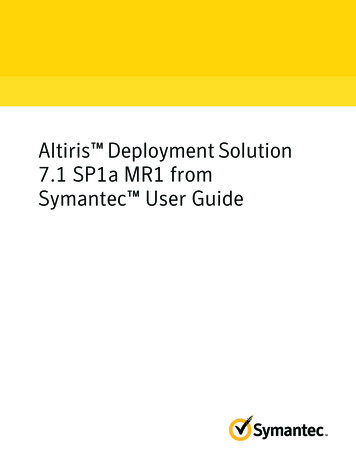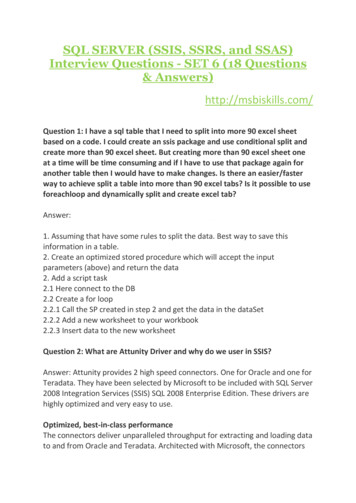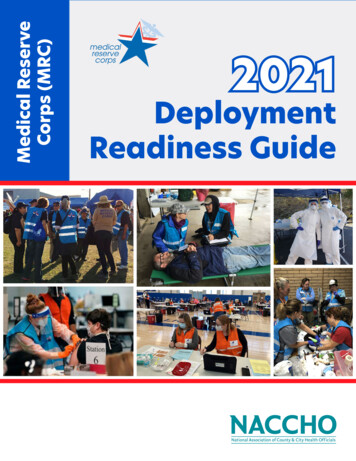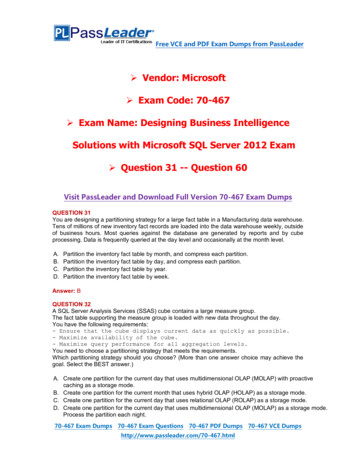
Transcription
SSAS - Designing,Development and DeploymentBest practicesAmit m
About Amit Bansal CTO, eDominer Systems & Peopleware India Corporate Trainer/Consultant & Evangelist Conducted more than 400 workshops on SQL Server &BI for top notch IT companies world wide Microsoft MVP for SQL Server Microsoft Certified Trainer Advisory Council member Speaker at TechED India, TechED US & TechED Europe Technical Reviewer – MSL courses on SQL Server SME – SQL Server 2008 certifications President – SQLServerGeeks.com
Agenda Problem StatementDimension DesignCube DesignPartitioningAggregationsSummary
Problem Statement You want:–––––Faster initial developmentEasier further developmentEasier maintenanceAgility and scalability in your designPerformance, Performance, Performance You need to design best, right from start ! (Doyou I really need to tell you this )
Agenda Problem StatementDimension DesignCube DesignPartitioningAggregationsSummary
Natural Hierarchies A hierarchy is a natural hierarchywhen each attribute included inthe user-defined hierarchy has aone to many relationship with theattribute immediately below it(every child member has onlyone parent) Server simply ―works better‖YearCountryQuarterStateMonthCityDate
Natural Hierarchies Performance implications– Only natural hierarchies are materialized on diskduring processing– Unnatural hierarchies are built on the fly duringqueries (and cached in memory)– Server internally decomposes unnatural hierarchiesinto natural components– Essentially operates like ad hoc navigation path (butsomewhat better)– Aggregation designer favors user defined hierarchies
Attribute italCustomerAge
Attribute Relationships Flexible relationships can changeCityCustomerCustomerPhone Number Rigid relationships do not changeStateQuarterCityMonth
Attribute Relationships Where are they used?– Storage Query performance– Greatly improved effectiveness of in-memory caching– Materialized hierarchies when present Processing performance: Fewer, smaller hash tables resultin faster, less memory intensive processing Aggregation design: Algorithm needs relationships in orderto design effective aggregations Member properties: Attribute relationships identify memberproperties on levels
Attribute Relationships Where are they used?– Semantics MDX overwrite semantics: City.Seattle State. WA State.OR City.All Non-key granularity (Aggregation Paths) Dimension security: DeniedSet {State.WA}
DEMOAttribute relationships & Naturalhierarchies
Dealing with Large Dimensions Optimizing Processing– Use natural hierarchies Good attribute/hierarchy relationships forces the AS engineto build smaller DISTINCT queries versus one large andexpensive query Consider size of other properties/attributes– Dimension SQL queries are in the form ofselect distinct Key1, Key2, Name, ,RelKey1, RelKey2, from [DimensionTable]
Dealing with Large Dimensions Important to tune your SQL statements––––Indexes to underlying tablesCreate a separate table for dimensionsAvoid OPENROWSET queriesUse Views to create your own version of ―querybinding‖ Size limitations for string stores and effect ondimension size– 4 GB, stored in Unicode, 6 byte per-string overhead.– E.g. 50-character name: 4*1024*1024*1024 /(6 50*2) 40.5 million members
Dimension Processing ByAttribute vs ByTable– This is a ProcessingGroup property Default ByAttribute– Advantages of ByTable Entire set of dimension data loaded into memory Theoretically processes data faster But BEWARE– Bypasses normal checks– Assumes there is enough memory to process allattributes concurrently– If this is not true
Dimension Processing ByAttribute vs ByTable– 2 dimensions Each 25M members with 8-10 attributes– ByTable Took 80% of available memory 25.6 / 32 GB Never completed– ByAttribute Only 28% of available memory 9 / 32 GB Process completed
Agenda Problem StatementDimension DesignCube DesignPartitioningAggregationsSummary
Cube Dimensions Dimensions– Consolidate multiple hierarchies into single dimension(unless they are related via fact table)– Use role-playing dimensions (e.g., OrderDate,BillDate, ShipDate)—avoids multiple physical copies– Use parent-child dimensions prudently No aggregation support– Set Materialized true on reference dimensions
Cube Dimensions Dimensions– Use many-to-many dimensions prudently Slower than regular dimensions, but faster than calculations Intermediate measure group must be ―small‖ relative toprimary measure group Consider creating aggregations on the shared commonattributes of the intermediate measure group
Measure Groups Common questions– At what point do you split from a single cube and create one ormore additional cubes?– How many is too many? Why is this important?– New measure groups adding new dimensions result in anexpansion of the cube space– Larger calculation space more work for the engine whenevaluating calculations
Measure Groups Guidance– Look at increase in dimensionality. If significant, and overlap withother measure groups is minimal, consider a separate cube– Will users want to analyze measures together?– Will calculations need to reference unified measures collection?
DEMOCube Design Best Practices
Agenda Problem StatementDimension DesignCube DesignPartitioningAggregationsSummary
Why Partition? Breaks large cubes into manageable chunks For measure groups, not dimensions Fact rows are distributedby a partitioning scheme– Managed by DBA– By Time: Sales for 2001, 2002, 2003, – By Geography: Sales for North America, Europe,Asia, Why?– For Manageability, Performance, Scalability
Benefits of Partitioning Partitions can be added, processed,deleted independently– Update to last month’s data does not affect priormonths’ partitions– Sliding window scenario easy to implement– e.g., 24 month window add June 2006 partitionand delete June 2004 Partitions can have different storage settings––––Storage mode (MOLAP, ROLAP, HOLAP)Aggregation designAlternate disk driveRemote server
Benefits of Partitioning Partitions can be processedand queried in parallel– Better utilization of server resources– Reduced data warehouse load times Queries are isolated to relevantpartitions less data to scan– SELECT FROM WHERE [Time].[Year].[2006]– Queries only 2006 partitions Bottom line partitions enable– Manageability, Performance & Scalability
Best Practices for Partitions General guidance: 20M rows per partition– Use judgment, e.g., perhaps better to have 500 partitions with 40million rows than 1000 20 million row partitions– Standard tools unable to manage thousands of partitions More partitions means more files– E.g. one 10GB cube with 250,000 files (design issues)– Deletion of database took 25min to complete Partition by time plus another dimension e.g. Geography– Limits amount of reprocessing– Use query patterns to pick another partitioning attribute When data changes– All data cache for the measure group is discarded– Separate cube or measure groups by ―static‖ and ―real-time‖analysis
Best Practices for PartitionsEqual Sized Partitions1120213031404150Not Equal Sized PartitionsJanuary 20081115162021252650
DEMOPartitioning
Agenda Problem StatementDimension DesignCube DesignPartitioningAggregationsSummary
Aggregations for queryperformance A subtotal of partition data–based on a set of attributes from each dimensionHighest-Level AggregationCustomerProductUnits SoldSalesAllAll347814123 345,212,301.30CustomersProductsIntermediate AggregationAll CustomersCountryStateCityNameAll its SoldSalesCansd4529456 23,914.30USyu6784623 57,931.45 FactscustIDSKUUnits SoldSales345-231351232 45.67563-0145123634 67.32
How many AggregationsCustomerProductTimeAll CustomersCountryStateCityNameAll ProductsCategoryBrandItemSKUAll TimeYearQuarterMonthDay 125 possible combinations (just for user-defined dimensions) 5 customer levels, 5 product levels, 5 time levels Imagine a cube with ten dimensions, five levels each 9,765,625 combinations! Then you add attribute hierarchies to the mix General rule: multiply the number of attributes in each dimension Goal should be to find the best subset of this potentially hugenumber of possibilitiesTradeoff between query performance and processing/storageoverhead
Aggregations for queryperformanceCustomersProductTimeAll Customers (1)Country (3)State (80)City (578)Name (3811)All Products (1)Category (60)Brand (911)Item (7621)SKU (8211)All Time (1)Year (3)Quarter (12)Month (36)Day (1095)Aggregations at lower levels have more possible rows (All, All, All)(Country, Item, Quarter)(Name, SKU, Day)1x1x13 x 7621 x 123811 x 8211 x 1095 1 274,356 34,264,872,495Actual number of rows depends on the data sparsitySize also depends on the number of measures
Aggregations for queryperformanceCustomersProductsTimeAll CustomersCountryStateCityNameAll ProductsCategoryBrandItemSKUAll TimeYearQuarterMonthDayQuery levelsAggregation usedMax Cells(All, All, All)(Country, Item, Quarter)(Country, Brand, Quarter)(Country, Category, All)(State, Item, Quarter)(City, Category, Year)(All, All, All)1(Country, Item, Quarter)274,356(Country, Item, Quarter)274,356(Country, Item, Quarter)274,356(Name, SKU, Day)34,264,872,495(Name, SKU, Day)34,264,872,495Using a higher-level aggregation means fewer cellsto consider
Best Practices for Aggregations Define all possible attribute relationships Set accurate attribute member countsand fact table counts Set AggregationUsage– Set rarely queried attributes to None– Commonly queried attributes to Unrestricted
Best Practices for Aggregations Not too many– In the 100s, not 1000s! Do not build aggregations 30% of fact table size
Best Practices for Aggregations1. Use Storage Design Wizard for the initialaggregations ( 20% perf gain)2. Enable query log3. Run pilot workload with limited users4. Refine with Usage Based Optimization Wizard5. Use a larger perf gain (70 %)6. Reprocess partitions for new aggregationsto take effect7. Periodically use UBO to refine aggregations
DEMOAggregations
Agenda Problem StatementDimension DesignCube DesignPartitioningAggregationsSummary
Summary Design for performance and scalability from the start Some fundamental principles carry through from SQL 7.0– Dimension design– Partitioning– Aggregations Critical to properly implement/utilize modeling capabilities introducedin SSAS 2005 and carried forward in 2008– Attribute relationships, natural hierarchies– Design alternatives: role-playing, many-to-many,reference dimensions, semi-additive measures– Flexible processing options SSAS 2008 development tools have been redesignedand enhanced to better assist in development ofhigh performance cubes
Resources Analysis Services 2005 Processing y/ms345142(v SQL.90).aspx Many-to-Many Dimensions in Analysis 345139(v SQL.90).aspx Analysis Services Query Performance Top 10 Best c966527.aspx SQL Server 2008 Analysis Services Performance 635(v SQL.100).aspx
ResourcesSoftware Application DevelopersInfrastructure technetindia
2011 Microsoft Corporation. All rights reserved. Microsoft, Windows, Windows Vista and other product names are or may be registered trademarks and/or trademarks inthe U.S. and/or other countries.The information herein is for informational purposes only and represents the current view of Microsoft Corporation as of the date of this presentation. Because Microsoftmust respond to changing market conditions, it should not be interpreted to be a commitment on the part of Microsoft, and Microsoft cannot guarantee the accuracy of anyinformation provided after the date of this presentation.MICROSOFT MAKES NO WARRANTIES, EXPRESS, IMPLIED OR STATUTORY, AS TO THE INFORMATION IN THIS PRESENTATION.
in SSAS 2005 and carried forward in 2008 - Attribute relationships, natural hierarchies - Design alternatives: role-playing, many-to-many, reference dimensions, semi-additive measures - Flexible processing options SSAS 2008 development tools have been redesigned and enhanced to better assist in development of high performance cubes




![[MS-SSAS-T]: SQL Server Analysis Services Tabular Protocol](/img/17/5bms-ssas-t-5d-200622.jpg)


![[MS-SSAS-T]: SQL Server Analysis Services Tabular](/img/37/ms-ssas-t-160714.jpg)


